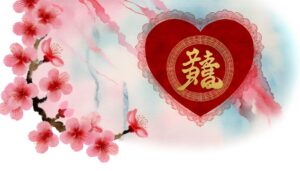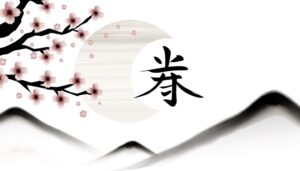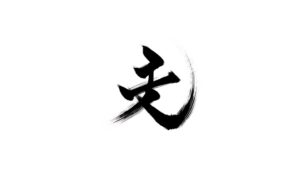Kanji Symbol for Pain in Japanese?
In Japanese, the kanji for pain is 痛 (tsuu), representing both physical pain and emotional suffering. This character combines the radical for illness (疒) with the phonetic component (甬), emphasizing its association with ailments and distress.
Originating from Chinese characters, it has evolved through cultural and historical influences, intertwining with elements of Shintoism, Buddhism, and traditional Japanese art and literature. Beyond its linguistic roots, this symbol embodies deeper themes of suffering and resilience.
Those interested in the intricate symbolism and cultural significance of 痛 will find it permeates various facets of Japanese life and expression.
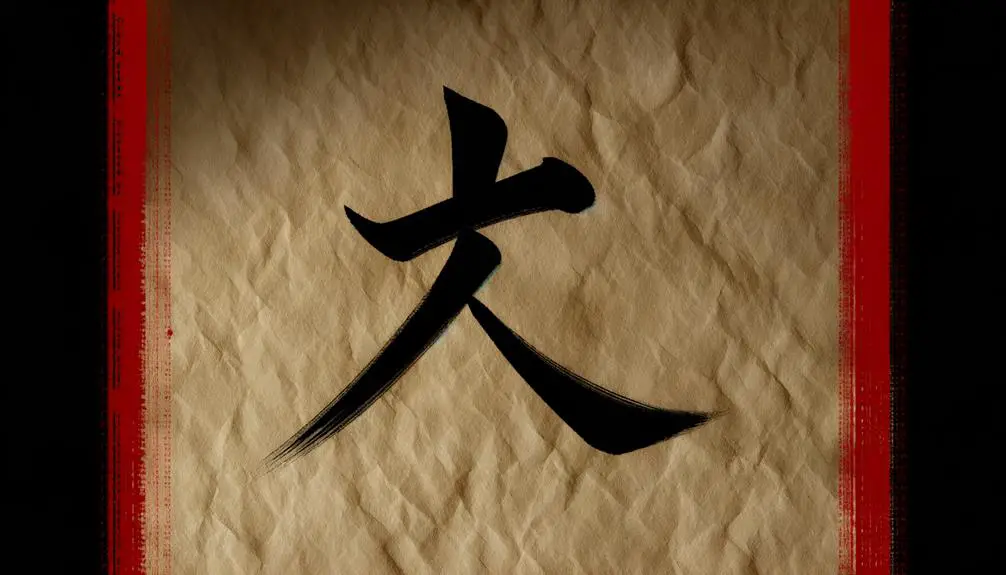
Key Takeaways
- The kanji for pain in Japanese is 悼 (tsuu), representing physical or emotional suffering.
- Composed of the illness radical and a phonetic component, 悼 has roots in classical Chinese characters.
- It symbolizes themes of suffering, endurance, and resilience in art, literature, and tattoos.
- The character encompasses both physical discomfort and deep psychological distress.
- 悼 is integral to expressing sorrow and existential anguish within Japanese culture.
The Kanji for Pain
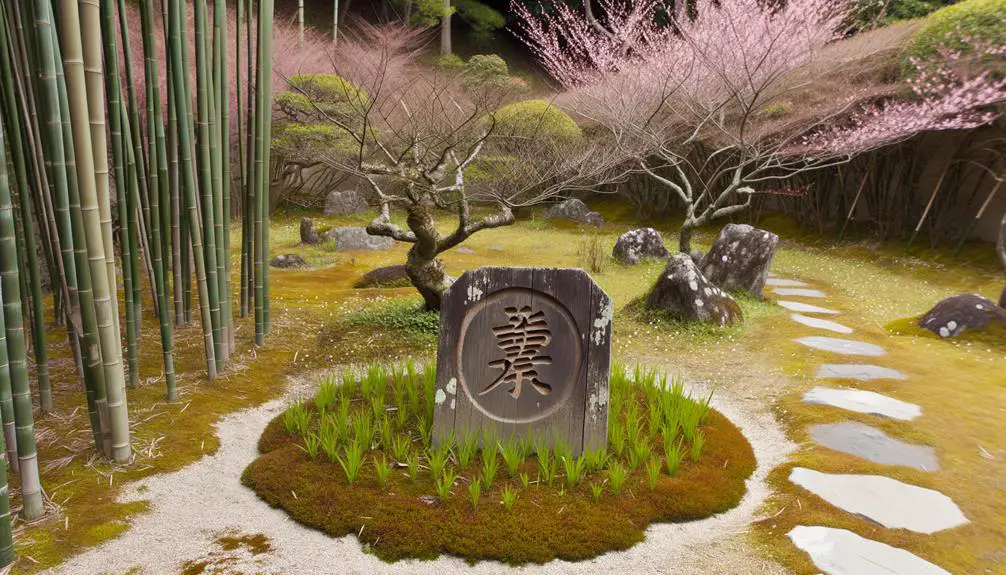
The kanji for pain in Japanese is 痛 (tsuu), which is composed of the radical for illness (疒) and the phonetic component 甬.
This character amalgamates the concept of sickness with a sound element that conveys discomfort. The radical 疒 (byou) typically appears in kanji associated with diseases and ailments, imparting a clear indication of physical or emotional suffering.
The phonetic component 甬 (yuu) adds a specific pronunciation, anchoring 痛 within the language's phonetic system. Understanding this kanji involves more than recognizing its parts; it requires an appreciation of the cultural context in which pain is perceived and expressed in Japanese society.
This character is commonly used in medical contexts, literature, and everyday language to denote various forms of pain.
Historical Origins
The historical origins of the symbol for pain in Japanese trace back to ancient scripts, where early forms of kanji were adopted from Chinese characters.
Over time, the cultural symbolism of pain evolved, influenced by societal values and historical context.
Additionally, linguistic exchanges and adaptations shaped the modern representation, reflecting a rich tapestry of influences.
Ancient Japanese Scripts
Ancient Japanese scripts, such as kanji derived from Chinese characters, provide a fascinating glimpse into the linguistic and cultural evolution of Japan. These scripts were instrumental in the development of the Japanese writing system and its integration of complex ideas.
- Kanji: Imported from China, these characters represent words or morphemes.
- Hiragana: Simplified form of kanji, used mainly for native Japanese words and grammatical functions.
- Katakana: Another simplified form, often employed for foreign words, technical terms, and names.
- Manyogana: An ancient script that utilized Chinese characters phonetically to represent Japanese sounds.
These scripts collectively enriched Japanese literature, administrative documentation, and religious texts, cementing their critical role in historical and contemporary Japanese society.
Cultural Symbolism Evolution
Tracing its roots back to antiquity, Japanese cultural symbolism has undergone significant evolution, reflecting shifts in societal values, religious beliefs, and artistic expression. Historically, symbols in Japan were deeply intertwined with Shintoism and Buddhism, shaping interpretations of pain and suffering. Over centuries, these influences merged with native folklore and the aesthetic principles of Wabi-Sabi, emphasizing beauty in imperfection and transience.
| Era | Symbolic Influence | Societal Impact |
|---|---|---|
| Jomon Period | Shinto Animism | Ritualistic and spiritual |
| Heian Period | Buddhist Iconography | Refined court culture |
| Edo Period | Ukiyo-e Woodblock Prints | Popular and accessible art |
| Meiji Period | Westernization | Modernization and change |
| Post-War Era | Contemporary Art Forms | Fusion of traditional/modern |
This table illustrates the dynamic evolution of cultural symbols, including those associated with pain, as they adapt to changing societal contexts.
Linguistic Influences Shaping Symbol
Building on the profound cultural symbolism of past eras, the linguistic nuances of the Japanese language have greatly shaped the representation and understanding of pain throughout history. The Japanese character for pain, 痛 (tsuu), derives from ancient Chinese script and has evolved through various historical contexts. This evolution reflects broader cultural and medical influences, emphasizing the interconnectedness of language and societal perceptions.
Historical Influence: The kanji 痛 has roots in classical Chinese medicine and philosophy.
Cultural Integration: The symbol has been adapted through centuries, integrating with Japanese ideologies.
Semantic Range: The character encompasses both physical and emotional pain, showcasing linguistic depth.
Modern Usage: Contemporary applications in medical literature and everyday language continue to reflect its historical origins.
Understanding these influences enriches our comprehension of pain within Japanese culture.
Linguistic Roots

The linguistic roots of the Japanese symbol for pain, 痛 (tsū), can be traced back to classical Chinese characters, reflecting a rich history of cultural and linguistic exchange.
Originating from the Chinese character 痛 (tòng), which also signifies pain, the kanji was assimilated into the Japanese lexicon via the kanbun system during the Heian period (794-1185). This period was marked by extensive borrowing of Chinese script and literary culture.
The character 痛 is composed of the radical 疒 (nè), indicating illness, and 甬 (yǒng), relating to a phonetic component. This amalgamation underscores the profound interconnection between linguistic elements and cultural transmission, highlighting the shared heritage and adaptation of language across East Asia.
Pronunciation Variants
Pronunciation variants of the Japanese symbol for pain, 痛 (tsū), illustrate the intricate ways in which phonetic nuances and regional dialects influence the articulation and understanding of kanji in Japan. While 'tsū' is the standard reading, certain contexts and regions may alter this pronunciation. These variants reflect not only regional dialects but also the kanji's integration into different linguistic structures.
- On'yomi (音読み): The Chinese reading 'tsū' is commonly used in compound words.
- Kun'yomi (訓読み): The native Japanese reading 'itai' or 'itamu' is often used in standalone contexts.
- Dialectal Variants: Regional dialects may modify the pronunciation subtly, reflecting local linguistic traits.
- Contextual Influence: Usage in medical terminology vs. everyday speech can affect pronunciation.
Understanding these nuances enriches one's grasp of Japanese language and culture.
Symbolic Meanings
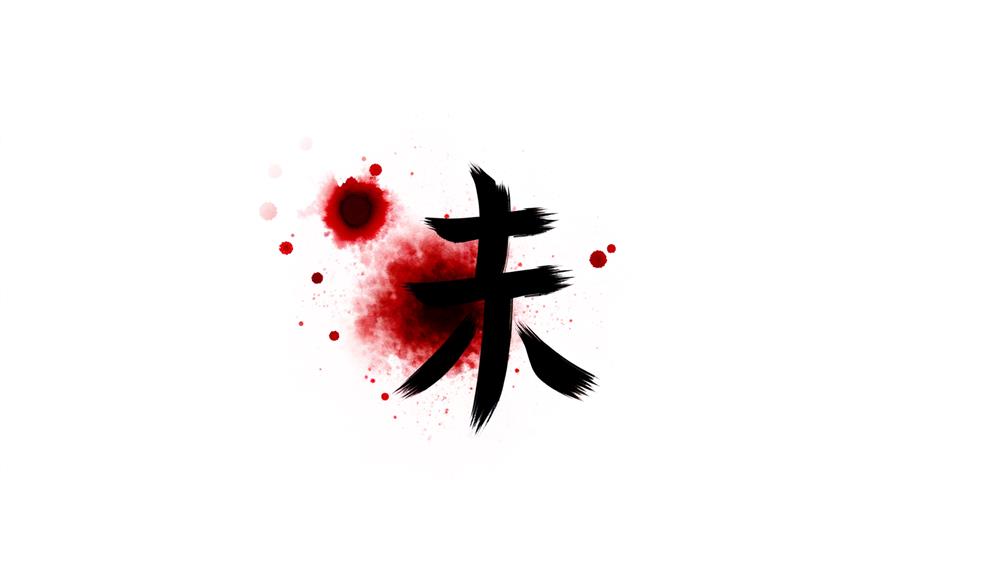
The kanji for pain (痛) carries profound historical and cultural significance in Japan, reflecting its diverse interpretations across time.
From ancient texts to modern usage, this symbol encapsulates not only physical suffering but also emotional and psychological distress.
Historical Symbolic Context
Throughout Japanese history, the kanji for pain, 痛 (tsū), has carried layers of symbolic meaning, reflecting societal attitudes toward suffering and endurance. This symbol often transcends its literal sense to embody deeper cultural values.
- Resilience: The kanji signifies not just physical pain but the emotional and psychological strength required to endure hardships.
- Sacrifice: It often symbolizes the sacrifices made for family and community, an integral aspect of Japanese collectivist culture.
- Purification: Pain is sometimes viewed as a purifying force, believed to cleanse the spirit and build character.
- Buddhist Influence: The notion of suffering aligns with Buddhist teachings on the nature of life, emphasizing the importance of enduring pain as a path to enlightenment.
These layers of meaning highlight the complex cultural perspectives surrounding pain in Japan.
Cultural Interpretations
In contemporary Japanese culture, the kanji for pain, 痛 (tsū), embodies a multi-faceted symbol that extends beyond its literal meaning to represent resilience, sacrifice, and spiritual growth.
Pain is often viewed not merely as suffering but as a transformative experience that cultivates strength and endurance. This kanji is imbued with the notion that enduring pain is a pathway to personal growth and enlightenment.
Additionally, in the context of communal and familial bonds, pain signifies the sacrifices made for the well-being of others, reflecting a deep-seated cultural value of selflessness.
The symbolic interpretations of 痛 underscore the Japanese ethos that adversity, while challenging, is an integral part of the journey toward a more profound and enlightened existence.
Modern Symbolic Usage
Modern usage of the kanji 痛 (tsū) in Japanese culture often extends to contemporary art, literature, and even fashion, where it symbolizes not just physical pain, but emotional and existential struggles. This kanji has evolved to represent a broader spectrum of human experience, resonating deeply with those seeking to express complex feelings.
- Art: Artists incorporate 痛 to convey themes of suffering and endurance.
- Literature: Authors use the kanji to depict characters' internal conflicts and traumas.
- Fashion: The symbol appears in avant-garde designs, representing raw, unfiltered emotion.
- Tattoos: Many choose 痛 to signify personal battles and resilience.
This multifaceted usage highlights the kanji's profound cultural significance, transcending its original meaning.
Emotional Significance
The Japanese symbol for pain, 痛 (itai), carries profound emotional significance, encapsulating a spectrum of feelings from physical discomfort to deep psychological distress.
Itai is not merely a descriptor of physical agony but also serves as an expression of emotional and mental suffering. In Japanese literature and poetry, 痛 often conveys a sense of lingering sorrow, existential anguish, or the burden of unspoken grief.
This multifaceted symbol resonates deeply within the Japanese cultural psyche, where the acknowledgment of pain, both visible and hidden, is integral to emotional expression.
The kanji itself, composed of elements signifying disease and suffering, encapsulates a holistic view of pain, emphasizing its pervasive impact on the human experience.
Cultural Context
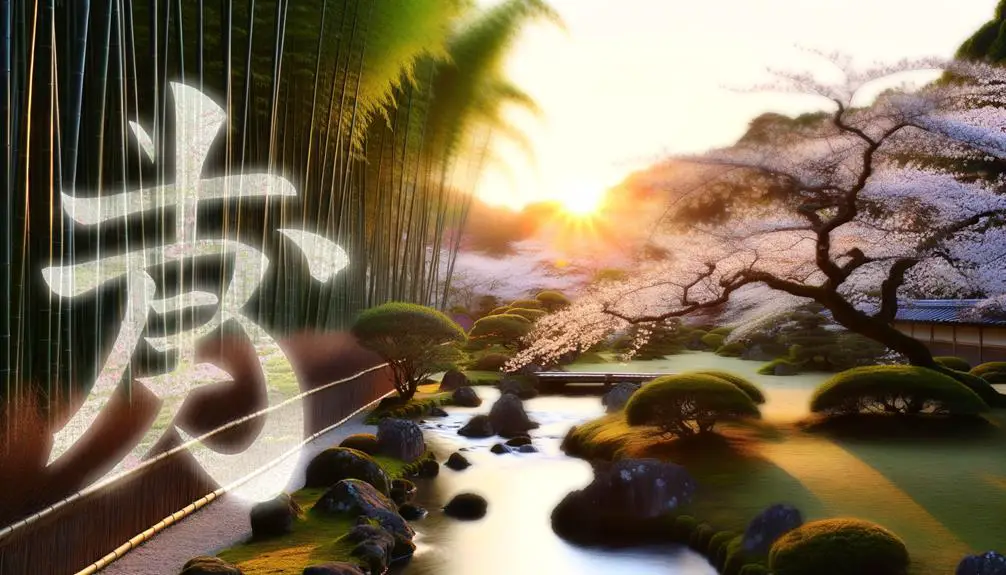
Understanding the emotional significance of 痛 (itai) requires an exploration of its roots within the cultural context of Japan, where the acknowledgment of pain is interwoven with historical, social, and philosophical dimensions. Pain, or 'itai,' is not merely a physical sensation but a complex experience shaped by various cultural factors.
In Japanese society, the expression and management of pain are influenced by:
- Buddhist philosophy that emphasizes the transient nature of suffering.
- Samurai ethos which valorizes stoicism and endurance.
- Interpersonal relationships where pain is often internalized to maintain social harmony.
- Traditional arts such as Noh and Haiku, which often reflect themes of suffering and resilience.
These elements collectively shape the nuanced understanding of pain in Japan.
Use in Literature
In Japanese literature, the symbol for pain (痛) is often employed to evoke deep emotional landscapes and to explore the multifaceted nature of human suffering.
Renowned authors like Yukio Mishima and Haruki Murakami use this kanji to articulate the inner turmoil of their characters, bridging the gap between personal agony and universal themes.
The symbol serves not only as a narrative device but also as a cultural touchstone, reflecting the profound ways in which pain shapes human experience.
Through poetry, prose, and historical texts, the character 痛 encapsulates a spectrum of afflictions, from physical ailments to existential despair, thereby offering readers a poignant lens through which to understand the complexities of life and emotion.
Representation in Art
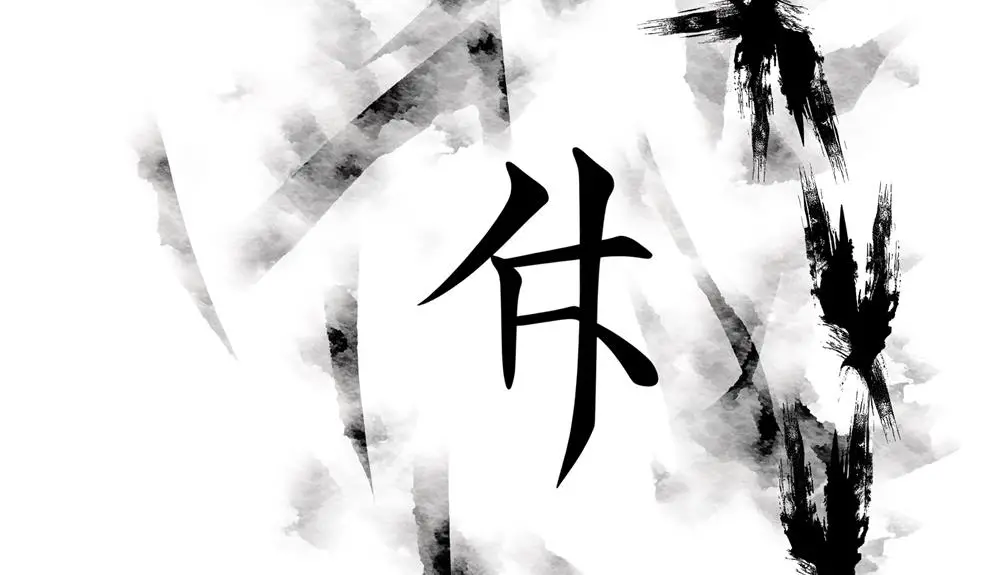
The depiction of pain in Japanese art manifests through various mediums, each offering unique cultural insights. Traditional Japanese tattoos, known as irezumi, often incorporate symbols of suffering and resilience.
Meanwhile, manga and anime use visual symbolism to convey emotional and physical pain, and contemporary artists reinterpret these themes to resonate with modern audiences.
Traditional Japanese Tattoos
How do traditional Japanese tattoos, known as irezumi, vividly encapsulate cultural narratives through their intricate designs and symbolism?
Irezumi serve as powerful visual storytelling mediums, embodying mythological, historical, and personal elements. These tattoos are often imbued with profound meanings, representing virtues, struggles, and life lessons through detailed imagery.
- Dragons: Symbolize strength, wisdom, and protection.
- Koi Fish: Represent perseverance and ambition.
- Cherry Blossoms: Reflect the transient nature of life and beauty.
- Demons (Oni): Emphasize themes of protection, justice, and the duality of human nature.
Irezumi's meticulous craftsmanship and symbolic depth offer a rich tapestry of cultural heritage, making them not just art forms but deeply personal narratives etched into the skin.
Manga and Anime Symbolism
Just as irezumi tattoos encapsulate rich cultural narratives through intricate designs, manga and anime employ symbolic imagery to convey deep emotional and thematic elements. Symbols in manga and anime often serve to illustrate internal states like pain, love, or fear, using visual metaphors that are universally understood.
Consider the following symbolic elements:
| Symbol | Representation |
|---|---|
| Tears | Emotional pain, sadness |
| Broken objects | Shattered dreams, loss |
| Shadows | Inner turmoil, depression |
These elements serve to deepen the audience's emotional connection, enhancing the storytelling experience. Such symbolic representations allow creators to communicate complex emotions succinctly, making the narrative more impactful and resonant with a diverse audience.
Contemporary Art Interpretations
In contemporary art, symbolizing pain often involves a nuanced interplay of color, form, and texture to evoke visceral emotional responses. Artists utilize a variety of methodologies to encapsulate the essence of suffering, often drawing from cultural and personal experiences.
- Color: Dark shades like black and deep reds are frequently employed to represent anguish and torment.
- Form: Distorted or fragmented shapes can illustrate the disintegration of the self or emotional turmoil.
- Texture: Rough, uneven surfaces might be used to convey raw, unfiltered pain.
- Cultural Symbols: Incorporating traditional Japanese symbols, such as the character 痛 (itai), can imbue artworks with profound cultural significance.
This multifaceted approach ensures that the portrayal of pain transcends mere visual representation, touching deeper psychological and emotional layers.
Everyday Expressions
Japanese everyday expressions often incorporate various words and phrases to convey pain, reflecting both cultural nuances and linguistic precision.
Common terms such as 痛い (itai) are frequently used to describe physical pain, akin to saying 'it hurts' in English.
Expressions like 心が痛む (kokoro ga itamu), translating to 'my heart aches,' articulate emotional pain.
In daily conversation, subtle variations, such as using ちょっと (chotto) for 'a little' pain or すごく (sugoku) for 'very' painful, offer nuanced communication.
The cultural emphasis on stoicism and indirect expression often leads to more subdued descriptions, subtly acknowledging discomfort without overt dramatization.
This linguistic approach underscores the Japanese value of maintaining harmony and composure even in the face of adversity.
Modern Interpretations

Modern interpretations of pain in Japanese culture are increasingly influenced by contemporary societal changes and the integration of Western medical and psychological concepts. This evolution is evident in how pain is expressed, treated, and understood within both clinical and everyday contexts. The influence of Western practices has led to a more holistic approach, recognizing the multifaceted nature of pain.
- Psychological Understanding: Recognition of mental and emotional components of pain.
- Technological Integration: Use of advanced medical technology for pain management.
- Holistic Approaches: Emphasis on integrating physical, mental, and emotional care.
- Cultural Shifts: Changing attitudes towards openly discussing and treating pain.
These modern interpretations reflect a broader, more nuanced understanding of pain, aligning traditional Japanese sensibilities with global health perspectives.
Conclusion
The kanji for pain, 痛, serves as a linguistic tapestry woven with historical intricacies and cultural depth. From its ancient origins to its nuanced pronunciation variants, this symbol embodies a spectrum of human suffering and resilience.
Its presence in literature and art amplifies its emotive power, while everyday expressions and modern interpretations keep its essence alive. Like a shadow cast over the human experience, 痛 remains an indelible mark on the canvas of language and culture.

